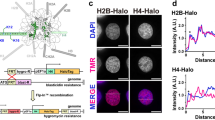Summary
Isolabeling observed during sister chromatid differentiation (SCD) was studied from human skin fibroblasts by the fluorescence-plus-Giemsa (FPG) technique. Bromodeoxyuridine (BrdU) was fed to exponentially dividing cells for 52 h to enable completion of two consecutive cycles of DNA replication. During this period, the late-replicating regions of some chromosomes were able to go through three replication cycles. These chromosome regions had evidently incorporated BrdU bifiliarly in both chromatids and hence, on staining with FPG, appeared isostained (isolabeled). Thus, incubation of exponentially dividing cells with BrdU for a period longer than that required for two cell cycles appears to be a suitable method for revealing the late-replicating regions of the genome, such as the X chromosome in a human female, as isolated.
In another experiment with Indian muntjac chromosomes, isolabeled segments were darkly stained, which suggested unifilar incorporation of BrdU. In this case, unequal crossing-over or an unequal distribution of thymine residues probably is responsible for the isolabel.
Similar content being viewed by others
References
Bender MA, Griggs HG, Bedford JS (1974) Recombinational DNA repair and sister chromatid exchanges. Mutat Res 24: 117–123
Deavan LL, Stubblefield E (1969) Segregation of chromosomal DNA in Chinese hamster fibroblasts in vitro. Exp Cell Res 55:132–135
Gatti M, Olivieri G (1973) The effect of X-rays on labeling pattern of M-1 and M-2 chromosomes in Chinese hamster cells. Mutat Res 17:101–112
Gerner-Schmidt P (1978) Radiation induced isostaining: Fact or a fiction. Chromosoma 66:281–285
Gibas Z, Limon J (1978) Isolabeling of long arm of human Y chromosome demonstrated by FPG technique. Chromosoma 69:113–120
Gibson DA, Prescott DN (1973) Sister chromatid exchanges in isolabeling. Exp Cell Res 83:445–447
Latt SL, Davidson RL, Lin MS, Gerald PS (1974) Lateral asymmetry in the fluorescence of human Y chromosomes stained with 33258 Hoechst. Exp Cell Res 87:425–429
Luchnik NV, Projadkova NA (1978) Isolabeling is a radiation-induced phenomenon. Chromosoma 63:11–20
Peacock WJ (1963) Chromosome duplication and structure as determined by autoradiography. Proc Natl Acad Sci (USA) 49:793–801
Shafer DA (1977) Replication by-pass model of sister chromatid exchanges and implications for Bloom's syndrome and Fanconi's anemia. Hum Genet 39:177–190
Sturtevant AH (1925) The effect of unequal crossing over at the bar locus in Drosophila. Genetics 10:117–147
Taylor JH, Woods PS, Hughs WS (1957) The organization and duplication of chromosomes as revealed by autoradiographic studies using tritium-labelled thymidine. Proc Natl Acad Sci (USA) 43:122–138
Tucci SM, Skalko RG (1977) Demonstration of lateral asymmetry in G-banded mouse embryo chromosomes. Experientia 33:1437–1438
Ved Brat S, Verma RS, Dosik H (1979) Sister chromatid exchange and caffein potentiation in the chromosomes of Indian muntjac. Mutat Res 63:325–334
Verma RS, Dosik H, Chowdry IH, Jhaveri RC (1978) Ring chromosome 13 in a child with minor dysmorphic features. Am J Dis Child 132:1018–1021
Weisblum B, de Haseth PL (1972) Quinacrine, a chromosome slain specific for deoxyadenylate deoxylhymidylate rich regions in DNA. Proc Natl Acad Sci USA 69:629–632
Wolff S, Perry P (1975) Insight on chromosome structure from sister chromatid exchange ratios and the lack of both isolabeling and heterolabeling as determined by the FPG technique. Exp Cell Res 93:23–30
Wolff S, Bodycote J, Rodin B (1978) Chromosomal labeling caused by three rounds of synthesis in late replicating regions. Chromosoma 69:179–183
Author information
Authors and Affiliations
Rights and permissions
About this article
Cite this article
Ved Brat, S., Verma, R.S. & Dosik, H. Sister chromatid differentiation and isolabeling of chromosomes. Hum Genet 56, 305–308 (1981). https://doi.org/10.1007/BF00274684
Received:
Revised:
Published:
Issue Date:
DOI: https://doi.org/10.1007/BF00274684




